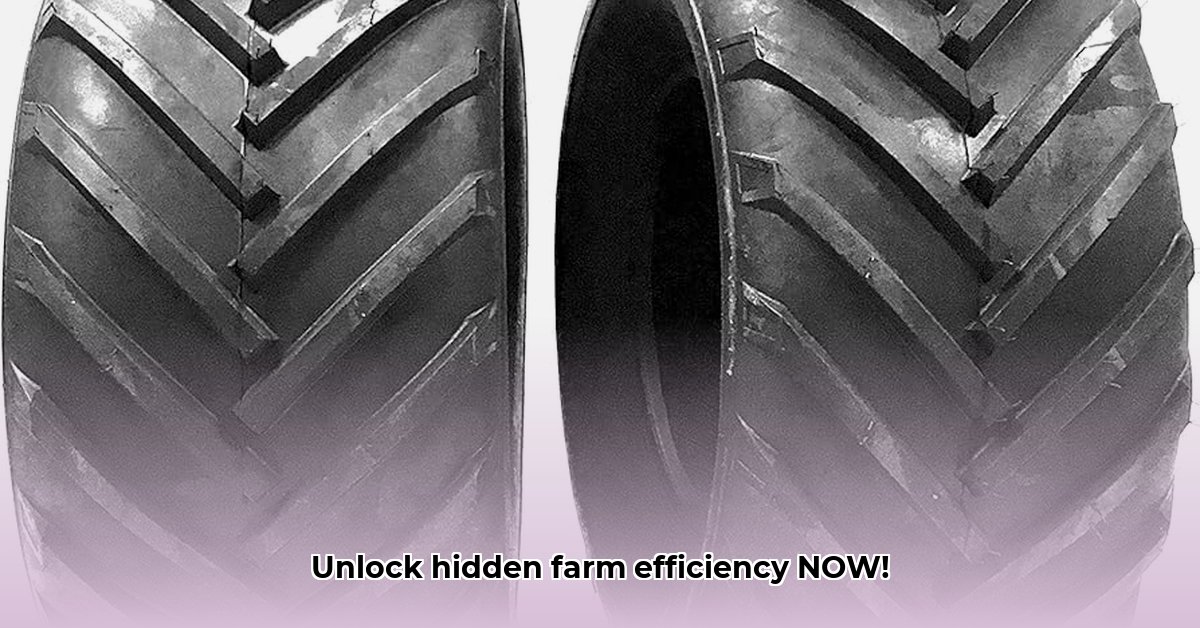
26x12x12 Tractor Tire: A Comprehensive Guide for Agricultural Use
Thinking about upgrading your tractor tires or maximizing the performance of your existing 26x12x12s? This guide provides actionable information to boost your farm's efficiency. We'll cover specifications, installation, maintenance, and troubleshooting, all explained in clear, concise language. For more on tire inflation, see this helpful guide: Tire Inflation Guide.
Are you ready to optimize your farm's operations and get the most out of your investment? Let's get started.
Decoding the 26x12x12: Understanding the Specifications
The numbers "26x12x12" represent the tire's diameter (approximately 26 inches), section width (approximately 12 inches), and rim diameter (12 inches). These dimensions directly impact the tire's load capacity and performance in various soil conditions. Understanding these specifications is the first step in choosing the right tire for your needs.
Ideal Applications for 26x12x12 Tractor Tires
This versatile tire size is perfect for smaller tractors used in various agricultural operations. Its compact size and maneuverability make it ideal for:
- Row crop farming: Minimizes crop damage while maximizing efficiency between rows.
- Light haulage: Simplifies moving supplies around the farm.
- Orchard and vineyard work: Allows for easy navigation around delicate plants, reducing damage risk.
- Hay baling: Provides consistent traction on uneven terrain.
However, remember that soil type significantly influences tire performance. A tire that performs excellently on hard-packed soil may struggle in muddy conditions. Consider your farm's soil types when choosing your tires. Isn't optimal tire selection crucial for efficient operations?
Installing and Maintaining Your 26x12x12 Tires: A Step-by-Step Guide
Proper installation and regular maintenance are crucial for extending tire lifespan and preventing equipment malfunctions. Follow these steps:
- Preparation: Clean the rim thoroughly, removing all dirt, debris, and rust. Inspect the tire for any damage.
- Mounting: Use appropriate tools for safe and even mounting. Avoid forceful actions to prevent damage.
- Inflation: Always adhere to the manufacturer's recommended inflation pressure. Underinflation reduces fuel efficiency and increases wear, while overinflation can lead to tire failure.
- Regular Inspection: Regularly inspect for cuts, excessive wear, and embedded objects. Adjust inflation as needed.
- Rotation: Rotate tires regularly to ensure even wear and extend their lifespan.
Following these steps ensures your tires remain in optimal condition. How often do you inspect your tires for wear and tear?
Troubleshooting Common Tire Issues
Even with proper maintenance, issues might arise. Here's how to address common problems:
- Uneven Wear: Often indicates inflation pressure or alignment problems. Consult a specialist for a professional alignment check.
- Excessive Wear: May result from improper inflation, poor alignment, or aggressive driving habits. Adjust practices accordingly.
- Punctures: Repair small punctures promptly with a patch. Large punctures require tire replacement.
Addressing these issues efficiently minimizes downtime and maximizes tire lifespan. What's your strategy for dealing with tire punctures?
Choosing the Right 26x12x12 Tire: Key Considerations
Tire selection involves more than just size. Consider these crucial factors:
- Tire Construction: Radial tires generally offer better fuel efficiency, a smoother ride, and longer lifespan compared to bias-ply tires.
- Tread Pattern: Open lugs provide superior traction in muddy conditions, while closed lugs are better for hard surfaces. Match the pattern to your typical terrain.
- Load Capacity: Select a tire with a load capacity exceeding your tractor's requirements to prevent damage or failure.
- Speed Rating: Choose a tire whose speed rating matches your operational needs and adheres to your tractor's recommendations.
Making informed choices helps avoid costly mistakes and maximizes tire performance. What factors do you prioritize when choosing your tractor tires?
Maximizing Fuel Efficiency and Minimizing Soil Compaction
Selecting tires for superior fuel efficiency and minimal soil compaction requires understanding tire construction, tread patterns, and inflation pressure.
Tire Construction: Radial vs. Bias-Ply
Radial tires generally exhibit better fuel efficiency and reduced soil compaction compared to bias-ply tires. This translates into cost savings and environmental benefits. However, bias-ply can be more cost-effective for specific less-demanding operations.
Tread Patterns: Optimizing Traction and Compaction
Various tread patterns cater to specific needs. Open lug treads offer maximum traction in soft soil, while closed lugs provide better performance on hard surfaces. Flotation tires are designed to minimize soil compaction in sensitive areas.
Tire Pressure: The Key to Efficiency
Maintaining optimal tire pressure is crucial for both fuel efficiency and minimizing soil compaction. Underinflation leads to increased rolling resistance and fuel consumption, while overinflation can damage the tire structure and enhance compaction. Regularly check and adjust pressure according to manufacturer recommendations.
A Step-by-Step Guide to Choosing Your Tires
- Consult Your Tractor Manual: Your tractor's specifications are your guide.
- Assess Tasks and Terrain: Identify the typical surfaces and loads you'll encounter.
- Consider Tire Construction: Radial tires usually offer better efficiency and longevity.
- Select Tread Pattern: Choose a pattern that suits your terrain and tasks.
- Verify Load Capacity: Ensure the tire can safely handle the intended load.
- Maintain Proper Inflation: Regularly check and adjust tire pressure.
Investing in high-quality tires ensures your farm operates efficiently, sustainably, and profitably for years to come. Remember, the initial investment in the right tires pays dividends in reduced fuel consumption, minimized soil damage, and increased longevity of your equipment.